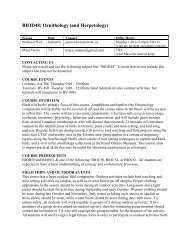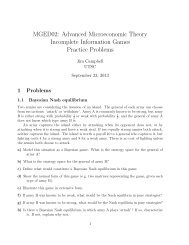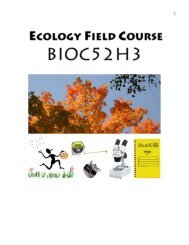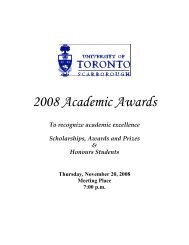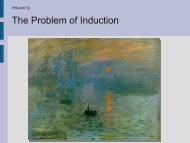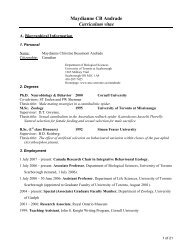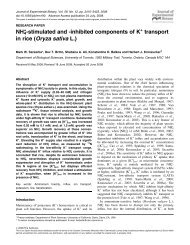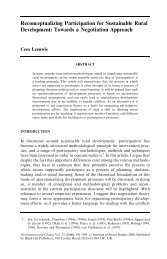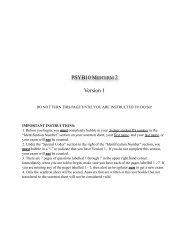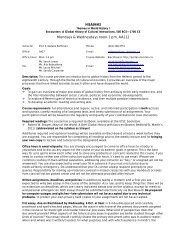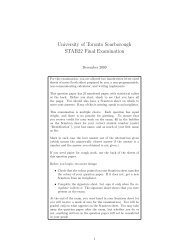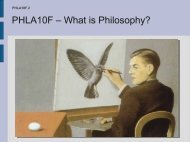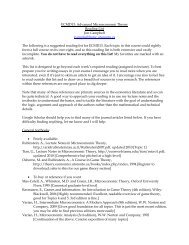[Enter course name - Syllabus] - University of Toronto Scarborough
[Enter course name - Syllabus] - University of Toronto Scarborough
[Enter course name - Syllabus] - University of Toronto Scarborough
- No tags were found...
You also want an ePaper? Increase the reach of your titles
YUMPU automatically turns print PDFs into web optimized ePapers that Google loves.
Between Two Worlds? Translators and Interpreters in HistoryHISD05H3Tuesday, 12pm-2pm, AA 209Instructor Pr<strong>of</strong>. E. Natalie Rothman Phone (416) 287-7159Office H324 E-mail rothman[at]utsc.utoronto.caOffice Hours Tuesdays 2pm-4pm Course Website http://portal.utoronto.caDescription:This D-level seminar will explore the social history <strong>of</strong> translators, interpreters, and the texts theyproduce. Through several case studies from Ireland and Istanbul to Québec, Mexico City, andGoa, we will ask how translators shaped public understandings <strong>of</strong> "self" and "other," "civilization"and "barbarity" in the wake <strong>of</strong> European colonization.Goals:‣ To learn about the history <strong>of</strong> translation and translators;‣ To explore the various approaches historians have taken to the study <strong>of</strong> translation and culturalmediation more broadly;‣ To develop analytical reading and writing skills;‣ To plan and carry out independent research.As a senior-year research seminar, this <strong>course</strong> aims to provide you with the skills you need in orderto develop and carry out an independent research project in history, including critical reading <strong>of</strong>secondary literature, compiling an annotated bibliography, developing an original argument usingevidence from primary documents, and writing a research statement, an outline, and, eventually,a research paper.Readings: All required readings will be available on Blackboard at least a week in advance. Youshould print out your own copies and have them with you for class.Response papers: Every week, you should post on Blackboard a short (1 page max) response tothe weekly readings by Monday at noon (i.e. 24 hours before class) to allow everyone to readeach other’s responses. Your response should not be a summary <strong>of</strong> the readings but rather a set <strong>of</strong>questions or comments that will serve as the basis for class discussion.In-class presentations: Based on a schedule to be determined at the beginning <strong>of</strong> the semester,you will be in charge <strong>of</strong> presenting a set <strong>of</strong> readings (usually 2-3 items). Your presentation shouldconsist <strong>of</strong> a 10-minute introduction that will situate the authors, summarize the arguments, andclarify key terms and concepts. You may also prepare a handout with some questions for thediscussion.Assignments: All assignments should be submitted through the Blackboard drop box by the stateddeadline. Be prepared for computer outages and glitches—I will not accept late submissions dueto any technical problems. If you foresee a medical/family emergency that will prevent you fromsubmitting your assignment on time, it is your responsibility to contact me in advance in order toseek an extension.Page 1
Course ScheduleWeek & Topic Date Readings1Introduction2Translators:Speaking toPower;Speaking forPower3MedievalTranslators LookBack: Greek,Latin, and theEmergence <strong>of</strong>VernacularLanguages <strong>of</strong>Empire4RenaissanceTranslators LookBeyond: Oldand NewKnowledge9 Jan.16 Jan.23 Jan.30 Jan.Williams, Roger. 1997 [1643]. “A Key into the Language <strong>of</strong> America, 1643.” In The EnglishLiteratures <strong>of</strong> America, 1500-1800. Eds. Myra Jehlen and Michael Warner. New York:Routledge, pp. 494-497.Lefevere, André et al. 1995. “Translators and the Reins <strong>of</strong> Power.” In Translators ThroughHistory. Eds. Jean Delisle and Judith Woodsworth. Amsterdam, Philadelphia: J.Benjamins, pp. 131-55.Hermans, Theo. 2001. “Shall I Apologize Translation?” Revised version <strong>of</strong> a public lecturedelivered at the Chinese <strong>University</strong> <strong>of</strong> Hong Kong on 31 March 2000. Available URL:http://eprints.ucl.ac.uk/archive/00000516/01/Ep_Apologizetrans.pdf.Robinson, Douglas. 1997. Translation and Empire: Postcolonial Theories Explained.Manchester: St. Jerome, pp. 8-45 (chaps. 1-2).For further reading:Blommaert, Jan. 2005. “Bourdieu the Ethnographer: the Ethnographic Grounding <strong>of</strong>Habitus and Voice.” Bourdieu and the Sociology <strong>of</strong> Translation and Interpreting.Special Issue <strong>of</strong> The Translator 11 (2): 219-36.Cheyfitz, Eric. 1997. The Poetics <strong>of</strong> Imperialism: Translation and Colonization. Philadelphia:<strong>University</strong> <strong>of</strong> Pennsylvania Press.Tymoczko, Maria and Edwin Gentzler. Eds. 2002. Translation and Power. Amherst: <strong>University</strong><strong>of</strong> Massachusetts Press.Venuti, Lawrence. 1995. The Translator’s Invisibility: A History <strong>of</strong> Translation. London, NewYork: Routledge.Pratt, Karen. 1991. “Medieval Attitudes to Translation and Adaptation: the RhetoricalTheory and the Poetic Practice.” In The Medieval Translator. Ed. Roger Ellis. London:Centre for Medieval Studies, Queen Mary and Westfield College, <strong>University</strong> <strong>of</strong> London,pp. 1-27.Twomey, Michael W. 2006. "Middle English Translations <strong>of</strong> Medieval Encyclopedias."Literature Compass 3 (3): 331-40.Spiegel, Gabrielle M. 1993. “Past Politics and the Politics <strong>of</strong> the Past: Ancient History I.” InRomancing the Past: The Rise <strong>of</strong> Vernacular Prose Historiography in Thirteenth-CenturyFrance. Berkeley: <strong>University</strong> <strong>of</strong> California Press, pp. 99-151.Sherman, Claire Richter. 1995. “Royal Patronage <strong>of</strong> Vernacular Translations.” In ImagingAristotle: Verbal and Visual Representation in Fourteenth-Century France. Berkeley:<strong>University</strong> <strong>of</strong> California Press, pp. 3-12.For further reading:Beer, Jeanette M. A. 1989. Medieval Translators and Their Craft. Kalamazoo, MI: MedievalInstitute Publications.Beer, Jeanette M. A. 1997. Translation Theory and Practice in the Middle Ages. Kalamazoo,MI: Medieval Institute Publications.Bisch<strong>of</strong>f, Bernhard. 1961. “The Study <strong>of</strong> Foreign Languages in the Middle Ages.” Speculum36 (2): 209-24.Kelly, Louis G. 1979. The True Interpreter: a History <strong>of</strong> Translation Theory and Practice in theWest. New York: St. Martin’s Press.Rener, Frederick M. 1989. Interpretatio: Language and Translation From Cicero to Tytler.Amstedam: Rodopi.Grendler, Paul F. et al. 1999. “Translation.” In Encyclopedia <strong>of</strong> the Renaissance, vol. 6. Ed.Paul F. Grendler. New York: Scribner, 1999, pp. 157-162.Burke, Peter. 2005. “The Renaissance Translator As Go-Between." In Renaissance Go-Betweens: Cultural Exchange in Early Modern Europe. Eds. Andreas Höfele and Wernerv. Koppenfels. Berlin, New York: Walter de Gruyter, pp. 17-31.Pfister, Manfred. 2005. “Inglese Italianato-Italiano Anglizzato: John Florio.” In RenaissanceGo-Betweens: Cultural Exchange in Early Modern Europe. Eds. Andreas Höfele andWerner von Koppenfels. Berlin, New York: Walter de Gruyter, pp. 32-54.Bartlett, Kenneth R. 2006. “Thomas Hoby, Translator, Traveler.” In Travel and Translation inthe Early Modern Period. Ed. Carmine Di Biase. Amsterdam, New York: Rodopi, pp.123-142.Page 3
Zhiri, Oumelbanine. 2006. “Leo Africanus and the Limits <strong>of</strong> Translation.” In Travel andTranslation in the Early Modern Period. Ed. Carmine Di Biase. Amsterdam, New York:Rodopi, pp. 175-186.Black, Cr<strong>of</strong>ton. 2002. "Leo Africanus's Descrittione Dell'Africa and Its Sixteenth-CenturyTranslations." Journal <strong>of</strong> the Warburg and Courtauld Institutes 65: 262-72.Davis, Natalie Zemon. 2006. “Translation, Transmission, and Distance.” In Trickster Travels: ASixteenth-Century Muslim Between Worlds. New York: Hill and Wang, pp. 223-244.“The worth <strong>of</strong> askilfull and worthytranslator is toobserue thesentences, figures,and formes <strong>of</strong>speech proposed inhis author, his truesence and height,and to adorne themwith figures andformes <strong>of</strong> orationfitted to the originallin the same tongueto which they aretranslated.”(George Chapman,1598)For further reading:Beer, Jeanette M. A. and Kenneth Lloyd-Jones. 1995. Translation and the Transmission <strong>of</strong>Culture Between 1300 and 1600. Kalamazoo, MI: Medieval Institute Publications.Blumenfeld-Kosinski, Renate and others. 2001. The Politics <strong>of</strong> Translation in the Middle Agesand the Renaissance. Ottawa: <strong>University</strong> <strong>of</strong> Ottawa Press.Botley, Paul. 2004. Latin Translation in the Renaissance: The Theory and Practice <strong>of</strong>Leonardo Bruni, Giannozzo Manetti and Desiderius Erasmus. New York: Cambridge<strong>University</strong> Press.Burke, Peter. 2005. “Lost (and Found) in Translation: A Cultural History <strong>of</strong> Translators andTranslating in Early Modern Europe.” [A slightly more detailed version <strong>of</strong> the author’sother article you read for this week] Available URL:http://www.nias.knaw.nl/en/new_3/new_1/new_26/.Davis, Natalie Zemon. 2006. Trickster Travels: A Sixteenth-Century Muslim Between Worlds.New York: Hill and Wang.DeLater, James A. 2002. Translation Theory in the Age <strong>of</strong> Louis XIV. Manchester, UK,Northampton MA: St. Jerome Pub.Denton, John. 1998. “Renaissance Translation Strategies and the Manipulation <strong>of</strong> aClassical Text. Plutarch From Jacques Amyot to Thomas North.” In Europe ettraduction. Ed. Michel Ballard. Ottawa: <strong>University</strong> <strong>of</strong> Ottawa Press, pp. 67-78.Di Biase, Carmine. Ed. 2006. Travel and Translation in the Early Modern Period. Amsterdam,New York: Rodopi.Hermans Theo. 1997. “The Task <strong>of</strong> the Translator in the European Renaissance: Explorationsin a Discursive Field.”Norton, Glyn P. 1984. The Ideology and Language <strong>of</strong> Translation in Renaissance Franceand Their Humanist Antecedents. Geneva: Droz.Woolard, Kathryn A. 2002. “Bernardo de Aldrete and the Morisco Problem: A Study in EarlyModern Spanish Language Ideology.” Comparative Studies in Society and History 44(3): 446-80.Worth, Valerie. 1988. Practising Translation in Renaissance France: The Example <strong>of</strong> ÉtienneDolet. Oxford: Clarendon.5Who Are theTranslators?6 Feb.Assignment 1 (book review/text analysis) due by 8am on Friday, 2 Feb.Hannay, Margaret P. 1994. “‘House-Confined Maids’: The Presentation <strong>of</strong> Woman’s Role inthe Psalmes <strong>of</strong> the Countess <strong>of</strong> Pembroke.” English Literary Renaissance 24 (1): 44-71.Pieretti, Marie-Pascale. 2002. “Women Writers and Translation in Eighteenth-CenturyFrance.” French Review 75 (3): 474-88.Smith, Theresa A. 2003. “Writing Out <strong>of</strong> the Margins: Women, Translation, and the SpanishEnlightenment.” Journal <strong>of</strong> Women’s History 15 (1): 116-43.Novoa, James N. 2006. “From Incan Realm to the Italian Renaissance: Garcilaso El Incaand His Translation <strong>of</strong> Leone Ebreo's Dialoghi D'Amore." In Travel and Translation in theEarly Modern Period. Ed. Carmine Di Biase. Amsterdam, New York: Rodopi, pp. 187-202.For further reading:Agorni, Mirella. 2002. Translating Italy for the Eighteenth Century: British Women Novelists,Translators and Travel Writers,1739-1797. Manchester: St. Jerome.Hannay, Margaret P. 1985. Silent but for the Word: Tudor Women as Patrons, Translators,and Writers <strong>of</strong> Religious Works. Kent, Ohio: Kent State <strong>University</strong> Press.Krontiris, Tina. 1992. Oppositional Voices: Women As Writers and Translators <strong>of</strong> Literature inthe English Renaissance. New York: Routledge.Pieretti, Marie-Pascale. 1998. "Women Writers and Translation in 18th-Century France."Unpublished PhD Dissertation. New York <strong>University</strong>.Page 4
6Research Skills 13 Feb.WorkshopReading week—20 Feb.7Translation and 27 Feb.Empire I:Conquest8Translation andEmpire II:Missionaries as 6 MarchTranslators;Translators asMissionariesIn-class workshop on research skills, identifying and using electronic resourcesAssignment 2: a 2-3 page annotated bibliography towards your final paper due by 10amon Monday, Feb. 19.To be confirmed: Visit to the Thomas Fisher LibraryRobinson, Douglas. 1997. “Translation as Empire: The Theoretical Record.” In Translationand Empire: Postcolonial Theories Explained. Manchester: St. Jerome, pp. 46-55.Palmer, Patricia. 2003. “Interpreters and the Politics <strong>of</strong> Translation and Traduction inSixteenth-Century Ireland.” Irish Historical Studies 33 (131): 257-77.Voigt, Lisa. 2002. “Captivity, Exile, and Interpretation in La Florida del Inca.” Colonial LatinAmerican Review 11 (2): 251-73.Fenton, Sabine and Paul Moon. 2002. “The Translation <strong>of</strong> the Treaty <strong>of</strong> Waitangi: a Case <strong>of</strong>Disempowerment.” In Translation and Power. Eds. Maria Tymoczko and EdwinGentzler. Amherst: <strong>University</strong> <strong>of</strong> Massachusetts Press, pp. 25-44.For further reading:Kabir, Ananya Jahanara. 2005. “Analogy in Translation: Imperial Rome, Medieval England,and British India.” In Postcolonial Approaches to the European Middle Ages:Translating Cultures. Eds. Ananya Jahanara Kabir and Deanne Williams. New York:Cambridge <strong>University</strong> Press, pp. 183-204.Mignolo, Walter D. 1995. The Darker Side <strong>of</strong> the Renaissance: Literacy, Territoriality, andColonization. Ann Arbor: <strong>University</strong> <strong>of</strong> Michigan Press.Palmer, Patricia A. 2001. Language and Conquest in Early Modern Ireland: EnglishRenaissance Literature and Elizabethan Imperial Expansion. New York: Cambridge<strong>University</strong> Press.Parker, John. 1965. Books to Build an Empire: A Bibliographical History <strong>of</strong> English OverseasInterests to 1620. Amsterdam: N. Israel.Rafael, Vicente L. 1988. “The Politics <strong>of</strong> Translation.” In Contracting Colonialism: Translationand Christian Conversion in Tagalog Society Under Early Spanish Rule. Ithaca: Cornell<strong>University</strong> Press, pp. 23-54.Rashkow, Ilona N. 1990. "Hebrew Bible Translation and the Fear <strong>of</strong> Judaization." TheSixteenth Century Journal 21 (2): 217-33.Barros, Maria Cândida D. M. 2001. “The Office <strong>of</strong> Lingua: A Portrait <strong>of</strong> the Religious TupiInterpreter in Brazil in the Sixteenth Century.” Itinerario 25 (2): 110-40.Silverman, David J. 2005. “Indians, Missionaries, and Religious Translation: CreatingWampanoag Christianity in Seventeenth-Century Martha’s Vineyard.” William andMary Quarterly 62 (2): 141-74.Zupanov, Ines G. 2005. “Twisting a Pagan Tongue: Portuguese and Tamil in JesuitTranslations.” In Missionary Tropics: The Catholic Frontier in India (16th-17th Centuries).Ann Arbor: <strong>University</strong> <strong>of</strong> Michigan Press, pp. 232-58.Bross, Kristina. 2004. “Wielding the Sword <strong>of</strong> God's Word: Translating and Reading theIndian ‘Bible’.” In Dry Bones and Indian Sermons: Praying Indians in Colonial America.Ithaca: Cornell UP, pp. 52-83.For further reading:Billings, Timothy. 2004. "Jesuit Fish in Chinese Nets: Athanasius Kircher and the Translation <strong>of</strong>the Nestorian Tablet." Representations 87: 1-42.Pardo, Osvaldo F. 2004. “The Mute and the Barbarian: Verbal and NonverbalCommunication in the Confession <strong>of</strong> the Nahuas.” In The Origins <strong>of</strong> MexicanCatholicism: Nahua Rituals and Christian Sacraments in Sixteenth-Century Mexico. AnnArbor: <strong>University</strong> <strong>of</strong> Michigan Press, pp. 104-130.Poirier, Lisa J. M. 2004. “Translators and Converts: Religion, Exchange, and Orientation inColonial New France, 1608--1680.” Unpublished PhD Dissertation. Syracuse <strong>University</strong>.Rafael, Vicente L. 1988. Contracting Colonialism: Translation and Christian Conversion inTagalog Society Under Early Spanish Rule. Ithaca: Cornell <strong>University</strong> Press.Page 5
9Translation andEmpire III:ColonialInterpreters13 MarchKarttunen, Frances E. 1994. “To the Valley <strong>of</strong> Mexico: Doña Marina, ‘La Malinche’ (ca.1500-1527).” In Between Worlds: Interpreters, Guides, and Survivors. New Brunswick:Rutgers <strong>University</strong> Press, pp. 1-23.Fayer, Joan M. 2003. “African Interpreters in the Atlantic Slave Trade.” AnthropologicalLinguistics 45 (3): 281-95.Couto, Dejanirah. 2003. “The Role <strong>of</strong> Interpreters, or Linguas, in the Portuguese EmpireDuring the 16th Century.” Electronic Journal <strong>of</strong> Portuguese History 1 (2): 1-9.Aguilar Moreno, Manuel. 2002. “The Indio Ladino As a Cultural Mediator in the ColonialSociety.” Estudios de cultura nahuatl 33: 149-84.Christelow, Allan. 1985. “Algerian Interpreters and the French Colonial Adventure in Sub-Saharan Africa.” The Maghreb review Majallat al-Maghrib 10 (4-6): 101-6.Kanya-Forstner, A. S. 1994. “French Missions to the Central Sudan in the 1890s: the Role <strong>of</strong>Algerian Agents and Interpreters.” Paideuma 40: 15-35.Hagedorn, Nancy L. 1988. “‘A Friend to Go Between Them’: The Interpreter As CulturalBroker During Anglo-Iroquois Councils, 1740-70.” Ethnohistory 35 (1): 60-80.Kawashima, Yasuhide. 1989. “Forest Diplomats: The Role <strong>of</strong> Interpreters in Indian-WhiteRelations on the Early American Frontier.” American Indian Quarterly 13 (1): 1-14.For further reading:Brooks, David C. 2001. “The Linguistic Conquest <strong>of</strong> Spanish America: First-ContactInterpreters and Translator Acquisition Strategy As Primary Cause <strong>of</strong> Military Conquest,1492-1565.” Unpublished PhD Dissertation. Auburn <strong>University</strong>.Karttunen, Frances E. 1994. Between Worlds: Interpreters, Guides, and Survivors. NewBrunswick: Rutgers <strong>University</strong> Press.Rothman, E. Natalie. Unpublished. “Dalmatians, Dragomans, and Dignitaries: Trans-Imperial Subjects and Cultural Mediation between Venice and Istanbul.”Price, Joshua. 2000. “Hybrid Languages, Translation, and Post-Colonial Challenges.” InBeyond the Western Tradition. Ed. Marilyn G. Rose. Binghamton: State <strong>University</strong> <strong>of</strong>New York, Center for Research in Translation, pp. 23-50.Standaert, Nicolas. 2003. “The Transmission <strong>of</strong> Renaissance Culture in Seventeenth-CenturyChina.” Renaissance Studies 17 (3): 367-391.10Borges, Jorge Luis. 2004 [1936] “The Translators <strong>of</strong> The Thousand and One Nights.” In TheTranslation and 20 MarchTranslation Studies Reader, 2 nd Edition. Ed. Lawrence Venuti. New York: Routledge, pp.34-48.CirculationFor further reading:Hung, Eva. Ed. 2005. Translation and Cultural Change: Studies in History, Norms and Image-Projection. Amsterdam, Philadelphia: J. Benjamins.Liu, Lydia H. 1995. Translingual Practice: Literature, National Culture and TranslatedModernity—China, 1900–1937. Stanford: Stanford <strong>University</strong> Press.Liu, Lydia H. 1999. Tokens <strong>of</strong> Exchange: The Problem <strong>of</strong> Translation in Global Circulations.Durham: Duke <strong>University</strong> Press.Student presentations11 27 MarchPaper outline due by noon on Monday, March 2612 3 April Student presentationsFinal paper due by 8am Thursday, April 5Page 6
Assignment 1: Due by 8am on Friday, 2 Feb.Option 1: Text analysisIn 3-5 double-spaced pages, analyse a translator’s preface and/or dedication (a list will beprovided at a later date). Using the analytical tools and strategies discussed in class, and buildingon your additional research in the secondary literature, identify the author, discuss the audienceand purpose <strong>of</strong> the preface & dedication, as well as <strong>of</strong> the book as a whole, and address anypertinent issues relating to translation based on our weekly discussions.Option 2: Book reviewIn 3-5 double-spaced pages, review one <strong>of</strong> the books below, or another scholarly book on thehistory <strong>of</strong> translation (by prior consultation with me):Davis, Natalie Zemon. 2006. Trickster Travels: A Sixteenth-Century Muslim Between Worlds. New York:Hill and Wang.Karttunen, Frances E. 1994. Between Worlds: Interpreters, Guides, and Survivors. New Brunswick:Rutgers <strong>University</strong> Press.Rafael, Vicente L. 1988. Contracting Colonialism: Translation and Christian Conversion in TagalogSociety Under Early Spanish Rule. Ithaca: Cornell UP.Roland, Ruth A. 1999. Interpreters As Diplomats: a Diplomatic History <strong>of</strong> the Role <strong>of</strong> Interpreters inWorld Politics. Ottawa: <strong>University</strong> <strong>of</strong> Ottawa Press.Rose, Marilyn G. Ed. 2000. Beyond the Western Tradition. Binghamton: State <strong>University</strong> <strong>of</strong> New York,Center for Research in Translation.Zupanov, Ines G. 2005. Missionary Tropics: The Catholic Frontier in India (16th-17th Centuries). AnnArbor: <strong>University</strong> <strong>of</strong> Michigan Press.For helpful suggestions on how to write a scholarly book review, see:http://www.utoronto.ca/writing/bkrev.htmlGeneral reference works and primary text collections:Baker, Mona and Kirsten Malmkjær. Eds. 1998. Routledge Encyclopedia <strong>of</strong> Translation Studies.London, New York: Routledge.Delisle, Jean and Judith Woodsworth. Eds. 1995. Translators Through History. Amsterdam,Philadelphia: J. Benjamins.Lefevere, André. Ed. 1992. Translation, History, Culture: A Sourcebook. New York: Routledge.Rener, Frederick M. 1989. Interpretatio: Language and Translation From Cicero to Tytler. Amstedam:Rodopi.Robinson, Douglas. Ed. 2002. Western Translation Theory: From Herodotus to Nietzsche. Manchester:St. Jerome Pub.Venuti, Lawrence. Ed. 2004. The Translation Studies Reader, 2 nd Edition. New York: Routledge.Page 7


![[Enter course name - Syllabus] - University of Toronto Scarborough](https://img.yumpu.com/50068522/1/500x640/enter-course-name-syllabus-university-of-toronto-scarborough.jpg)
